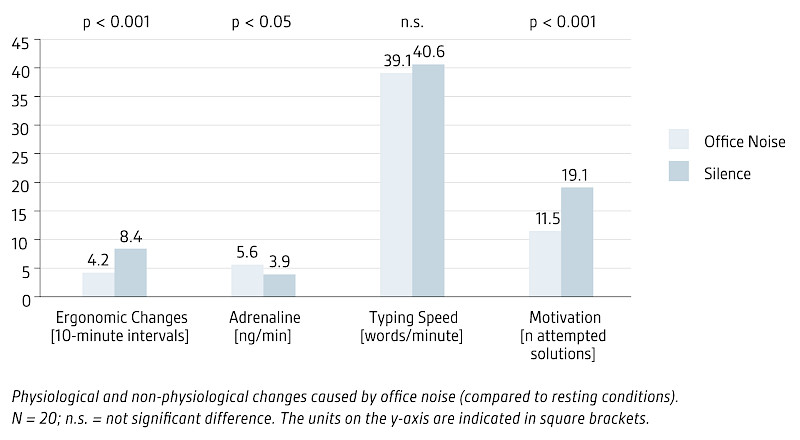Noise is unwanted sound (interference noise) that is perceived as disturbing or annoying.
Noise leaves no one unaffected. Numerous studies have demonstrated how diverse the effects of noise can be. Here are three examples:
Sust / Lazarus (2002)
In Research Report FB 794 of the Federal Institute for Occupational Safety and Health (BAuA), psychologist and educational scientist Ch. A. Sust and Professor Dr.-Ing. Lazarus examined the “Effects of moderately intense noise on simulated office and screen-based tasks of varying complexity.” To this end, they conducted numerous studies.
Key findings:
Noise with relatively high intensity and information content significantly impaired the performance of test subjects. The more complex the tasks became, the stronger the effect. Test subjects needed more time to complete their tasks and made more mistakes. At the same time, they required longer recovery periods. Tasks often had to be checked more frequently and restarted several times. Where complex tasks were to be carried out, test subjects exposed to noise even tended to leave tasks incomplete and abandon the work.
The extent of the effects depends on a variety of factors. How loud a sound event is perceived does not depend solely on its objective volume (sound pressure), but also on its pitch (frequency). Sounds in the frequency range between 2,000 and 5,000 Hz are subjectively perceived as significantly louder than sounds outside this range at the same sound pressure. Human speech lies within this frequency range.
Evans und Johnson (2000)
G. W. Evans and D. Johnson published a study entitled “Stress and open-office noise,” focusing specifically on the stress-inducing effect of noise. The study was published in the Journal of Applied Psychology, 2000/85(5), pp. 779–783.
Key findings:
At the end of a three-hour office session, the levels of stress-related steroid hormones (adrenaline, noradrenaline and cortisol) were measured in the urine of 20 participants. One half worked in a quiet environment, the other at a moderate noise level of 55 dB(A). The US researchers found that the higher noise level caused a significant increase in adrenaline levels. No significant effects were found for noradrenaline and cortisol. Typing speed, used as an indicator of performance, changed very little. However, the researchers observed that the noisier environment left participants almost paralysed. Those working at 55 dB(A) changed their posture only half as often as those in the comparison group. They also refrained from adjusting their chairs, monitors or keyboards, thereby increasing the risk of back and neck pain.
Klatte, Bastian, Meis et al. (2007)
M. Klatte, J. Bastian, M. Meis and B. Noack investigated the effect of noise on mental performance. Their study, entitled “Effects of background noise and reverberation on speech perception and working memory in different age groups,” was published in Fortschritte der Akustik. Proceedings of the 33rd Annual Conference on Acoustics, DAGA 2007, Stuttgart.
Key findings:
The research group from Eichstätt and Aachen examined the impact of speech on cognitive performance. For example, 20 participants were asked to memorise sequences of numbers and recall them as accurately as possible while exposed to speech noise. The results showed that whether speech was perceived as disturbing largely depended on its volume (35 vs. 55 dB). When the volume was reduced, participants found the test considerably less stressful. However, the error rate remained almost equally high. In order to reduce errors as well, the intelligibility of the speech signal also had to be lowered.
These and many other studies show that unwanted speech noise leads to stress and reduced performance. Moreover, people exposed to noise tend to give up more quickly on demanding tasks and move less. The studies also demonstrate that simply reducing the volume of speech noise is not sufficient – its intelligibility must also be reduced by appropriate measures.
In the IBA Forum showrooms, you will also find solutions for improved acoustics.





